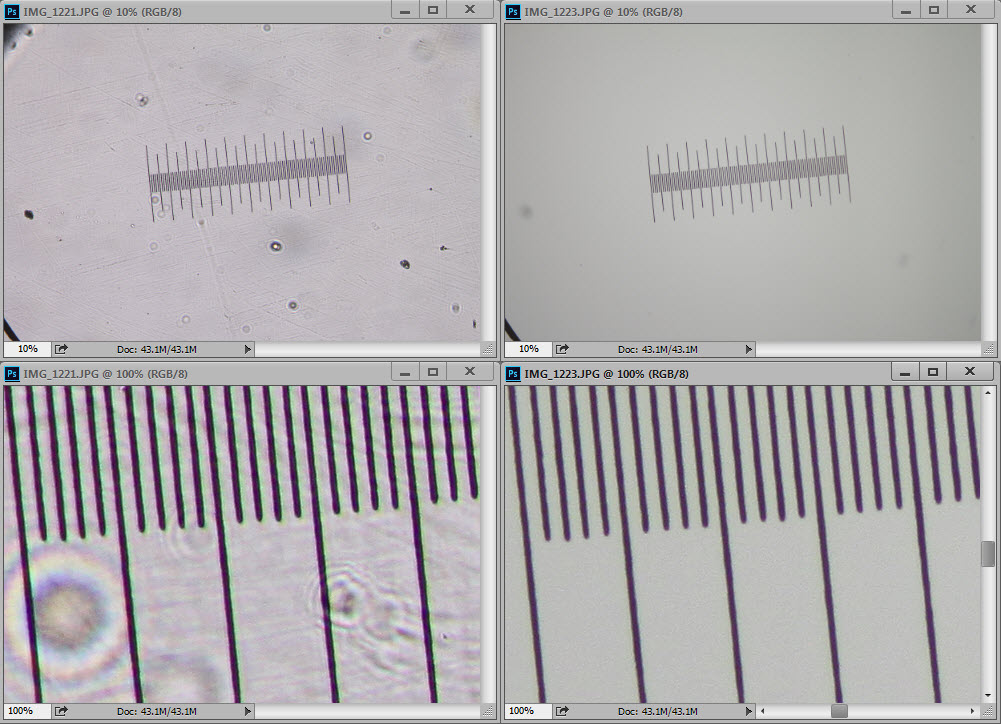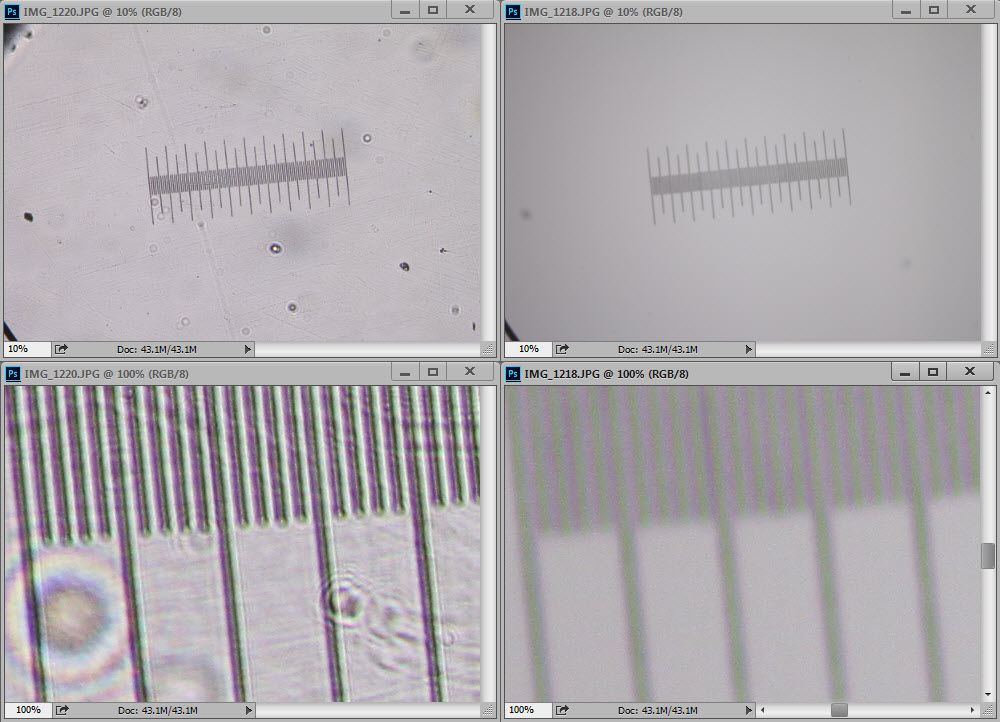If I shine a halogen desk lamp down onto a specimen sat on the stage of an inverted microscope (no intermediate lenses), what is the effective N.A. of the light source?
If I place half a table tennis ball over the specimen in the above configuration, does that increase the effective N.A. of the light source?
Numerical aperture of a naked light bulb?
Moderators: rjlittlefield, ChrisR, Chris S., Pau
- rjlittlefield
- Site Admin
- Posts: 23603
- Joined: Tue Aug 01, 2006 8:34 am
- Location: Richland, Washington State, USA
- Contact:
Without the diffuser, the illumination NA is equal to half the lamp width divided by distance to subject. This can approach 0.0 .
With the diffuser, the illumination NA gets much larger. It would be 1.0 if the diffuser were evenly illuminated. But because the sides of the diffuser are not illuminated so brightly, falling off to dark along the sides, the sort-of-effective NA is smaller, perhaps 0.7 .
The effect of the diffuser should be blatantly obvious on out-of-focus detail.
Here is a dusty and badly laminated stage micrometer, shot once illuminated with a bare Jansjö LED die at about 14 inches, and again with a half pingpong ball placed around the subject. The rule is focused. Note the dramatic rings around the out-of-focus dust on the left side, versus the almost complete invisibility of dust on the right side.

Note also that the effect on focused detail is not as large as we might guess at first thought. This is because focused detail is governed by some rule along the lines of (NA_obj + min(NA_obj,NA_cond)), while out-of-focus detail is more governed by the condenser alone.
If I defocus the rule slightly, this is what happens (bare LED on the left, pingpong diffuser on the right):

Does this help?
--Rik
Further details: Shot with Nikon CF N Plan Achromat 10X NA 0.25, direct projection onto a Canon T1i, displayed by Photoshop from high-quality JPEGs straight from camera.
With the diffuser, the illumination NA gets much larger. It would be 1.0 if the diffuser were evenly illuminated. But because the sides of the diffuser are not illuminated so brightly, falling off to dark along the sides, the sort-of-effective NA is smaller, perhaps 0.7 .
The effect of the diffuser should be blatantly obvious on out-of-focus detail.
Here is a dusty and badly laminated stage micrometer, shot once illuminated with a bare Jansjö LED die at about 14 inches, and again with a half pingpong ball placed around the subject. The rule is focused. Note the dramatic rings around the out-of-focus dust on the left side, versus the almost complete invisibility of dust on the right side.

Note also that the effect on focused detail is not as large as we might guess at first thought. This is because focused detail is governed by some rule along the lines of (NA_obj + min(NA_obj,NA_cond)), while out-of-focus detail is more governed by the condenser alone.
If I defocus the rule slightly, this is what happens (bare LED on the left, pingpong diffuser on the right):

Does this help?
--Rik
Further details: Shot with Nikon CF N Plan Achromat 10X NA 0.25, direct projection onto a Canon T1i, displayed by Photoshop from high-quality JPEGs straight from camera.
Very useful info, thanks Rik.
I need to (temporarily) increase the working distance between light source and specimen on my Zeiss inverted, while preserving reasonable resolution (about N.A. 0.5-0.6 will do - with up to 100mm clearance). I just wanted to put some numbers to the results I was seeing with setups not involving the condenser. The table tennis ball isn't really an option, but a largish piece of white card spotlit from below should do.
Thanks again for the comprehensive response.
Cheers
I need to (temporarily) increase the working distance between light source and specimen on my Zeiss inverted, while preserving reasonable resolution (about N.A. 0.5-0.6 will do - with up to 100mm clearance). I just wanted to put some numbers to the results I was seeing with setups not involving the condenser. The table tennis ball isn't really an option, but a largish piece of white card spotlit from below should do.
Thanks again for the comprehensive response.
Cheers
Rik, do you think you're getting those dust effects due to partial-coherence in the system? Diffraction ringing around the dust is like what I've seen in interferometry setups. In the lab it is usually a full coherence effect since monochromatic sources are used. In the lab, diffusion also solves the problem, even though it is laser light.
- rjlittlefield
- Site Admin
- Posts: 23603
- Joined: Tue Aug 01, 2006 8:34 am
- Location: Richland, Washington State, USA
- Contact:
Yes, I think it is just the same as dust with a small aperture.
I normally think of the ringing in terms of classic diffraction, not explicitly in terms of coherence although of course classic diffraction implicitly assumes coherence within a temporal window size corresponding to the maximum wavefront error.
But it seems like the behavior would also make sense in terms of partial coherence, since the NA of the illumination source is much smaller than that of the imaging system. Maybe revisit the Goodman reference as discussed at http://www.photomacrography.net/forum/v ... 689#126689?
Anyway, for more "fun with pinholes", see Rainbow Rings regarding Fresnel diffraction.
--Rik
I normally think of the ringing in terms of classic diffraction, not explicitly in terms of coherence although of course classic diffraction implicitly assumes coherence within a temporal window size corresponding to the maximum wavefront error.
But it seems like the behavior would also make sense in terms of partial coherence, since the NA of the illumination source is much smaller than that of the imaging system. Maybe revisit the Goodman reference as discussed at http://www.photomacrography.net/forum/v ... 689#126689?
Anyway, for more "fun with pinholes", see Rainbow Rings regarding Fresnel diffraction.
--Rik
